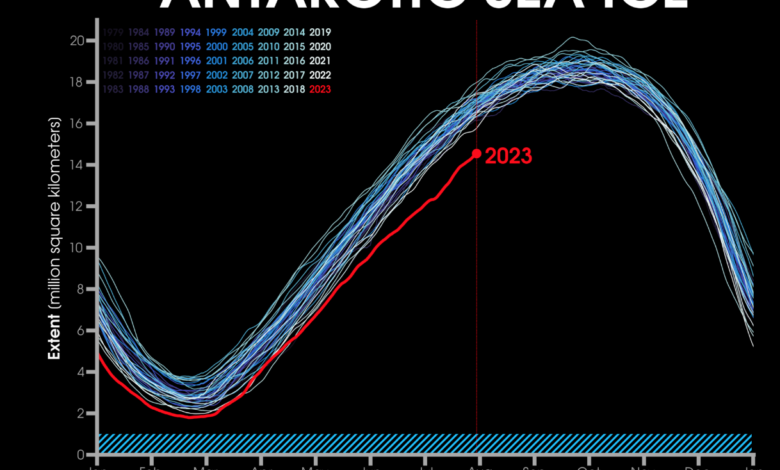Never so little sea ice in Antarctica: how will it affect the global climate?

Less ice means less albedo and more solar energy captured by the ocean
The South Pole is missing a larger piece of ice than Greenland. Although the southern hemisphere is full winter, the sea ice of Antarctica is struggling to regenerate and has been at an all-time low for months. For the whole of 2023, the extension of the part of the shell that floats on the ocean was much lower than the reference average.
Over 6 standard deviations less
If the negative record was already visible in February, that is, at the peak of the Antarctic summer, the anomaly continued to grow in a clear way in the following months. To understand how exceptional this situation is, some data must be considered.
In the last days of July, the Antarctic sea ice shortfall exceeded the 6 standard deviations from the average (it is at 6.65σ). The standard deviation is an index that is used in statistics to indicate the probability of an event. The higher the deviation, the more the event has little chance of happening. An event like the current one, at 6σ, has a chance of repeating only 1 time every about 3 million years.
According to data from Climate Reanalyzer, edited by the University of Maine, as of July 30, the extent of the Antarctic ice sheet was 14.55 million km2. In 2022, when it had set the previous negative record, the cap covered 15.76 million km2: 1.2 million km2 more. In practice, compared to 2022, this year Antarctica lacks an ice surface 4 times the size of Italy.
Why is the sea ice of Antarctica important?
Scientists are not sure that they can attribute this dynamic to climate change of anthropic origin. Unlike the trend of ice in the Arctic, in fact, at the South Pole the dynamics do not seem to follow the trend of global warming. In recent years there have also been several positive records. But surely a value as low as 2023 will affect the global climate.
The role of the albedo
The South Pole shell has an important role in regulating the Earth’s energy balance, whose imbalance at the end of July reached the new absolute record with 1.97 W/m2 (average 12 months). It all depends on the albedo, that is the amount of solar radiation that is reflected away from the Earth. The more ice covers the sea, the more solar energy will be sent back into space from the icy, brighter surface. On the contrary, the less sea ice there is, the more energy is captured by the ocean, the darker.
Permafrost virus: how dangerous are they?
The effects on the global climate
The effect is not small. According to a study by the Finnish Meteorological Institute published in 2021, between 2000 and 2015, The expansion of the Antarctic sea ice cover has produced a cooling effect that has largely balanced the warming effect caused by melting ice in the Arctic region.
Not only that. This extra energy is transported elsewhere by the ocean and can have global effects. In addition to heating Antarctic waters and contributing, in a vicious circle, to melting more sea ice in Antarctica, the heat transported can help to unbalance the Earth’s climate system as a whole, with effects on hurricanes, heat waves, precipitation in many areas of the globe. Added to El Niño, which alone could add up to 0.2°C of global warming, it could thus help make 2024 the first year the world exceeds the 1.5 threshold.





